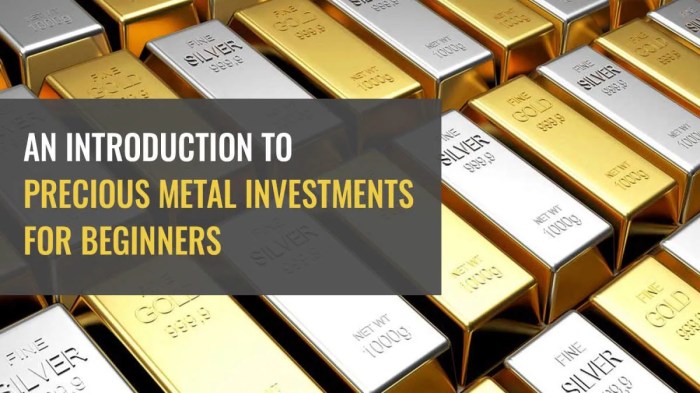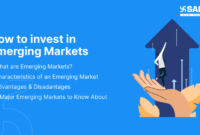Gold and precious metals investment takes center stage in the financial world, offering a unique opportunity to safeguard your wealth and hedge against economic uncertainties. This comprehensive guide delves into the benefits, types, factors influencing prices, and risks associated with investing in these valuable assets.
Benefits of Gold and Precious Metals Investment

Investing in gold and other precious metals offers a range of advantages compared to traditional investment options. These benefits make them a valuable addition to any investment portfolio.
Hedge Against Inflation and Economic Uncertainties
Gold and precious metals are known to act as a hedge against inflation and economic uncertainties. During times of economic instability or when the value of fiat currencies is decreasing due to inflation, the value of gold and precious metals tends to rise. This makes them a reliable store of value that can help protect your wealth during turbulent economic times.
Diversification
One of the key benefits of investing in gold and precious metals is the diversification they offer to an investment portfolio. By adding assets that have a low correlation to traditional stocks and bonds, investors can reduce overall portfolio risk. This diversification can help cushion the impact of market fluctuations and provide stability during volatile market conditions.
Types of Gold and Precious Metals Investments

Investors looking to add gold and precious metals to their portfolios have several options to choose from. Each type of investment comes with its own set of pros and cons, as well as varying levels of liquidity and storage requirements.
Physical Bullion
Investing in physical bullion involves purchasing gold or precious metals in the form of coins, bars, or other physical items. This type of investment provides investors with tangible assets that they can hold onto. However, storing physical bullion can be a challenge, as it requires secure storage facilities and insurance against theft or damage.
ETFs (Exchange-Traded Funds)
ETFs offer investors the opportunity to invest in gold and precious metals without actually owning physical assets. These funds are traded on stock exchanges like regular stocks, providing investors with liquidity and flexibility. However, ETFs come with management fees and may not always track the price of gold or metals accurately.
Mining Stocks
Investing in mining stocks involves buying shares of companies involved in the extraction and production of gold and precious metals. This type of investment allows investors to benefit from the potential growth of mining companies. However, mining stocks are also subject to company-specific risks and market volatility.
Futures Contracts, Gold and precious metals investment
Futures contracts are agreements to buy or sell gold or precious metals at a predetermined price on a future date. This type of investment is highly speculative and requires a good understanding of the commodities market. Futures contracts offer high liquidity but also come with significant risks, including leverage and price fluctuations.
Comparison of Liquidity and Storage Requirements
- Physical Bullion: Requires secure storage facilities and insurance. Less liquid compared to ETFs.
- ETFs: Highly liquid and can be traded on stock exchanges. No physical storage required.
- Mining Stocks: No physical storage needed, but subject to market volatility. Liquidity depends on the trading volume of the stocks.
- Futures Contracts: High liquidity but require a good understanding of the commodities market. No physical storage required.
Factors Influencing Gold and Precious Metals Prices
Gold and precious metals prices are influenced by a variety of factors that can impact their value in the market. Understanding these key factors is crucial for investors looking to make informed decisions in this sector.
Supply and Demand Dynamics
Supply and demand dynamics play a significant role in determining the prices of gold and precious metals. When demand exceeds supply, prices tend to rise as the scarcity of the metal increases its value. Conversely, an oversupply can lead to price decreases as the market becomes saturated.
Geopolitical Events
Geopolitical events such as wars, political instability, and trade disputes can have a major impact on the prices of gold and precious metals. Uncertainty in the global political landscape often drives investors towards safe-haven assets like gold, causing prices to surge.
Interest Rates and Currency Fluctuations
Changes in interest rates and currency fluctuations can directly influence the prices of gold and precious metals. Typically, when interest rates are low, the opportunity cost of holding non-interest-bearing assets like gold is reduced, leading to higher demand and prices. Additionally, fluctuations in currency values can affect the purchasing power of investors, thereby impacting the prices of these metals.
Macroeconomic Indicators
Macroeconomic indicators such as inflation, GDP growth, and central bank policies also play a crucial role in determining the prices of gold and precious metals. Inflationary pressures often drive investors towards tangible assets like gold to preserve their wealth, causing prices to rise. Similarly, strong GDP growth and accommodative central bank policies can boost investor confidence and drive up metal prices.
Investor Sentiment and Market Speculation
Investor sentiment and market speculation can create fluctuations in gold and precious metals prices. Positive sentiment towards these assets can lead to increased buying activity, driving prices higher. Conversely, negative sentiment or speculative trading can result in price declines as investors move away from these metals.
Risks Associated with Gold and Precious Metals Investment
Investing in gold and precious metals can offer significant benefits, but it also comes with its fair share of risks. Understanding these risks is crucial for investors looking to add these assets to their portfolios.
Price Volatility
Price volatility is a significant risk associated with gold and precious metals investment. The prices of these assets can fluctuate rapidly due to various factors such as economic indicators, geopolitical events, and market sentiment. Investors need to be prepared for sudden price swings that can impact the value of their investments.
Geopolitical Risks
Geopolitical risks also play a role in determining the prices of gold and precious metals. Events such as political instability, conflicts, and trade wars can create uncertainty in the market, leading to fluctuations in the prices of these assets. Investors should be aware of the potential impact of geopolitical events on their investments.
Regulatory Risks
Regulatory risks are another consideration for gold and precious metals investors. Changes in regulations related to mining, trading, or taxation can affect the market dynamics and prices of these assets. Investors need to stay informed about regulatory developments that could impact their investments.
Market Liquidity and Storage Costs
Market liquidity and storage costs are practical risks that investors need to consider when investing in gold and precious metals. Limited liquidity in the market can make it challenging to buy or sell these assets at desired prices. Additionally, storing physical gold or precious metals can incur storage costs that can eat into potential returns.
Historical Events Impacting Prices
Historical events have shown how risks can materialize in the gold and precious metals market. For example, the financial crisis of 2008 led to a surge in gold prices as investors sought safe-haven assets. Similarly, geopolitical tensions or natural disasters can trigger price movements in these assets. Understanding the historical context can help investors prepare for potential risks in the future.
In conclusion, investing in gold and precious metals can be a strategic move to protect your assets and achieve diversification in your portfolio. With careful consideration of the various investment options and risks involved, you can navigate the dynamic landscape of the precious metals market with confidence and potential for long-term growth.
Understand how the union of Best investment platforms for beginners can improve efficiency and productivity.


